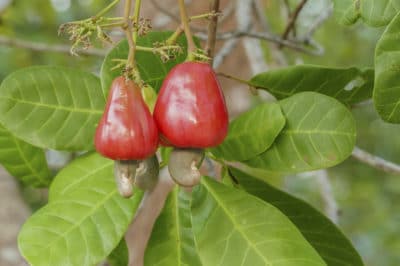Where Cashew Trees Grow
Cashew trees (Anacardium occidentale) are native to a stretch of northeastern Brazil lying between the Atlantic and Amazonian rainforests. In the late 16th century, the Portuguese imported them to eastern Africa and western India. While they’re rated suitable for USDA plant hardiness ones 10b through 12, only south Florida has the overall climate they need. To flourish, cashew trees require:
- Temperatures that stay above freezing — and ideally, above 50°F (10°C).
- Yearly rainfall of about 40 to 80 inches (1000 to 2000 mm). Their harvest increases with the rain.
- No rainfall during the harvest or while the trees are in bloom. In wet weather, the ripe nuts may decay or sprout. If it rains while the trees are blooming, fungal diseases target the flowers.
Cashew Fruit Development
Cashews develop in branching clusters at the ends of their tree’s youngest shoots. Beginning as pale-green buds, they open into tiny, fragrant yellowish-pink flowers less than ½ inches long. Each pollinated flower becomes a small, kidney-shaped fruit. Inside it is the edible cashew seed.
A Cashew Apple a Day Keeps the Doctor Away
As the fruits ripen, they change from pink to grayish-green. But the most remarkable change happens when their stalks swell into glossy, pepper-shaped cashew apples. The 2- to 4-inch, red or yellow apples are packed with nutrients including phosphorous, carotene, calcium and iron. They also have five times the Vitamin C of oranges their size.
Cashew Apple Recipes
Cashew apple jam (Dulce de Cajuil) is a favorite dessert from Dominican Republic’s northwestern La Linea region. Peeled cashew apples are blanched in water and cooled three times, then candied in syrup of sugar, cinnamon, cloves and prunes. The dessert keeps for a week when refrigerated.
In Jamaica, cashew apples are washed, cubed and blended with water to make a puree. Afterthe fiber is strained out, the juice is consumed as is or mixed with vanilla extract and a small amount of sweetened condensed milk for a refreshingly tangy-sweet treat.
Some Brazilian and Indian growers ferment fresh cashew apple juice in the sun and distill it into tasty liquor.
Cashew Fruits: Handle with Care
Inside the double husks protecting cashew seeds are 12 substances capable of triggering immune system responses. Two of them, anacardic acid and cardol, may cause severe skin rashes. A third is the phenolic resin found in varnishes and insecticides. Always wear gloves and protective clothing when handling unprocessed cashews.
Growing Cashew Trees
Do you dream of growing your own cashews? Given the right climate and care, cashew trees can produce their first harvest in as little as 18 months from planting.
Where to Plant
The healthiest, most productive cashew trees grow on sites with:
- Six or more hours of sun each day.
- Well-draining, sandy loam soil.
- Enough room to space them between 23 and 29 feet (7 to 9 meters) apart and 15 to 20 feet (4.6 and 6 meters) from structures or power lines.
Expert gardener’s tip: Cashew trees require good drainage their roots from drowning.
Choose Your Trees
Tempted grow cashew trees from seeds? Just don’t expect them to grow into replicas of their parents. What you can expect is to wait three years for your first harvest. To guarantee the kind of tree you’ll get — and to enjoy your first cashews in as little as 18 months — plant nursery-grafted cashew trees.
How to Plant Cashew Trees
Things you’ll need:
- A rotary tiller
- A garden spade
- A hose
- Organic mulch such as shredded bark or leaves
Step 1: Till the planting site well to loosen the soil. Step 2: Remove weeds and debris.
Step 2: Dig holes twice as wide and the same depth as the trees’ nursery containers.
Step 3: Slide a tree from its pot, taking care not to disturbing its roots.
Step 4: Spread the roots gently, center the tree in a hole and begin replacing the soil.
Step 5: Tamp the soil lightly to remove air pockets when the hole is half full.
Step 6: Finish filling the hole and tamp it again.
Step 7: Water thoroughly to settle the soil.
Step 8: Maintain a 2- to 4-inch layer of shredded leaves or other organic mulch around the trees for moisture retention and weed control. Keep it at least 8 inches away from the tree trunks.
Caring for Young Cashew Trees
A cashew tree needs the most TLC during the first three years after planting. Water it daily for two weeks, then once weekly for the next two months. After that, water weekly only if there’s been no rain for five days. After it’s producing fruit, water only during very long dry periods.
Expert gardener’s tip: Always water slowly and deeply to protect the roots from waterlogging. Using a soaker hose or drip system is best.
Feeding
Once each year, give your trees a slow, consistent stream of organic nutrition with well-aged cow or chicken manure. After rain has wet the soil, dig a 5 feet from the base of each tree. It should be 6 inches deep and 10 inches wide. Fill each trench with the manure; you don’t need to water it in.
Additional Nutrients
Cashew trees planted in chalky soils benefit from a yearly application of foliar spray containing zinc, boron, manganese and copper. Apply the spray — available at most garden centers — at the manufacturer’s recommended rate.
Pruning Older Trees
To maximize your cashew production, prune the trees lightly each year after harvest. Cut back just a few of the upper limbs so sunlight can penetrate the lower canopy. Prune the limbs back to their trunk crotches. Caution: Pruning a large cashew tree is best left to a professional.
